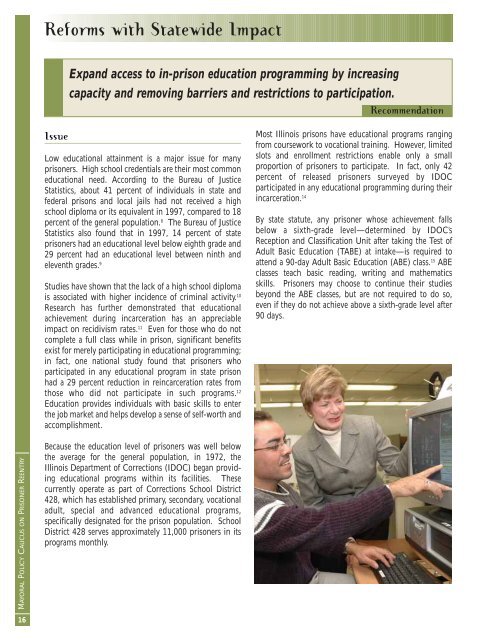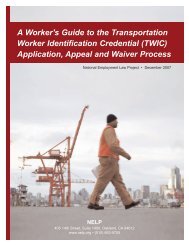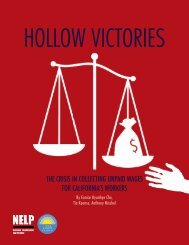Rebuilding Lives. Strengthening Communities.
Rebuilding Lives. Strengthening Communities.
Rebuilding Lives. Strengthening Communities.
Create successful ePaper yourself
Turn your PDF publications into a flip-book with our unique Google optimized e-Paper software.
Reforms with Statewide Impact<br />
Expand access to in-prison education programming by increasing<br />
capacity and removing barriers and restrictions to participation.<br />
Recommendation<br />
Issue<br />
Low educational attainment is a major issue for many<br />
prisoners. High school credentials are their most common<br />
educational need. According to the Bureau of Justice<br />
Statistics, about 41 percent of individuals in state and<br />
federal prisons and local jails had not received a high<br />
school diploma or its equivalent in 1997, compared to 18<br />
percent of the general population. 8 The Bureau of Justice<br />
Statistics also found that in 1997, 14 percent of state<br />
prisoners had an educational level below eighth grade and<br />
29 percent had an educational level between ninth and<br />
eleventh grades. 9<br />
Studies have shown that the lack of a high school diploma<br />
is associated with higher incidence of criminal activity. 10<br />
Research has further demonstrated that educational<br />
achievement during incarceration has an appreciable<br />
impact on recidivism rates. 11 Even for those who do not<br />
complete a full class while in prison, significant benefits<br />
exist for merely participating in educational programming;<br />
in fact, one national study found that prisoners who<br />
participated in any educational program in state prison<br />
had a 29 percent reduction in reincarceration rates from<br />
those who did not participate in such programs. 12<br />
Education provides individuals with basic skills to enter<br />
the job market and helps develop a sense of self-worth and<br />
accomplishment.<br />
Most Illinois prisons have educational programs ranging<br />
from coursework to vocational training. However, limited<br />
slots and enrollment restrictions enable only a small<br />
proportion of prisoners to participate. In fact, only 42<br />
percent of released prisoners surveyed by IDOC<br />
participated in any educational programming during their<br />
incarceration. 14<br />
By state statute, any prisoner whose achievement falls<br />
below a sixth-grade level—determined by IDOC’s<br />
Reception and Classification Unit after taking the Test of<br />
Adult Basic Education (TABE) at intake—is required to<br />
attend a 90-day Adult Basic Education (ABE) class. 15 ABE<br />
classes teach basic reading, writing and mathematics<br />
skills. Prisoners may choose to continue their studies<br />
beyond the ABE classes, but are not required to do so,<br />
even if they do not achieve above a sixth-grade level after<br />
90 days.<br />
MAYORAL POLICY CAUCUS ON PRISONER REENTRY<br />
Because the education level of prisoners was well below<br />
the average for the general population, in 1972, the<br />
Illinois Department of Corrections (IDOC) began providing<br />
educational programs within its facilities. These<br />
currently operate as part of Corrections School District<br />
428, which has established primary, secondary, vocational<br />
adult, special and advanced educational programs,<br />
specifically designated for the prison population. School<br />
District 428 serves approximately 11,000 prisoners in its<br />
programs monthly.<br />
16
















